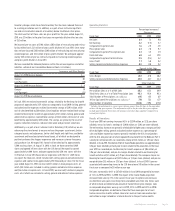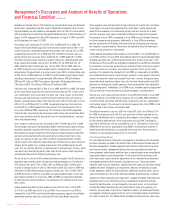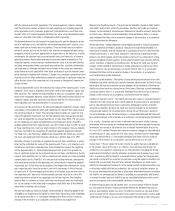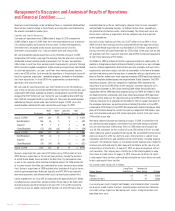Walgreens 2010 Annual Report Download - page 20
Download and view the complete annual report
Please find page 20 of the 2010 Walgreens annual report below. You can navigate through the pages in the report by either clicking on the pages listed below, or by using the keyword search tool below to find specific information within the annual report.
Management’s Discussion and Analysis of Results of Operations
and Financial Condition
Certain provisions of the Deficit Reduction Act of 2005 (the DRA) sought to
reduce federal spending by altering the Medicaid reimbursement formula (AMP)
for multi-source drugs. Those reductions did not go into effect. The ACA enacted
a modified reimbursement formula for multi-source drugs, which, when imple-
mented, is expected to reduce Medicaid reimbursements. Also, in conjunction
with a class action settlement with two entities that publish the average whole-
sale price (AWP) of pharmaceuticals, the methodology used to calculate the AWP,
a pricing reference widely used in the pharmacy industry, was changed in a way
that reduced the AWP for many brand-name prescription drugs effective
September 26, 2009. The Company has reached understandings with most of its
third party payers to adjust reimbursements to correct for this change in meth-
odology; however, most state Medicaid programs that utilize AWP as a pricing
reference did not take action to make similar adjustments, resulting in reduced
Medicaid reimbursement for drugs affected by the change.
Total front-end sales have continued to grow primarily due to new store openings.
Total front-end sales continue to be impacted by lower demand for discretionary
goods such as household, seasonal and beauty products due to the overall
economic conditions and high unemployment rates.
We continue to expand into new markets and increase penetration in existing
markets. To support our growth, we are investing in prime locations, technology
and customer service initiatives. We continue to expand, focused on retail organic
growth; however, consideration is given to retail and other acquisitions that
provide unique opportunities and fit our business objectives, such as our recent
acquisition of Duane Reade Holdings, Inc., and Duane Reade Shareholders, LLC
(Duane Reade), which consisted of 258 Duane Reade stores located in the New
York City metropolitan area, as well as the corporate office and two distribution
centers. This acquisition increased the Company’s presence in the New York
metropolitan area.
Restructuring
On October 30, 2008, we announced a series of strategic initiatives, approved by
the Board of Directors, to enhance shareholder value. One of these initiatives was
a program known as “Rewiring for Growth,” which was designed to reduce cost
and improve productivity through strategic sourcing of indirect spend, reducing
corporate overhead and work throughout our stores, rationalization of inventory
categories, and transforming community pharmacy. We expect to complete these
initiatives in fiscal 2011.
We have recorded the following pre-tax charges associated with our Rewiring for
Growth program in the Consolidated Statements of Earnings
(In millions):
Twelve Months Ended August 31, 2010 2009
Severance and other benefits $ 16 $ 74
Project cancellation settlements — 7
Inventory charges 19 63
Restructuring expense 35 144
Consulting 50 76
Restructuring and restructuring related costs $ 85 $ 220
Cost of sales $ 19 $ 63
Selling, general and administrative expenses 66 157
$ 85 $ 220
Severance and other benefits include the charges associated with employees
who were separated from the Company. In the current fiscal year,
193 employees have been separated from the Company. Since inception,
a total of 890 employees have been separated from the Company as
a result of these initiatives.
The following discussion and analysis of our financial condition and results of
operations should be read together with the financial statements and the related
notes included elsewhere herein. This discussion contains forward-looking state-
ments that involve risks and uncertainties. Our actual results may differ materially
from those discussed in forward-looking statements. Factors that might cause a
difference include, but are not limited to, those discussed under “Cautionary Note
Regarding Forward-Looking Statements” below and in Item 1A (Risk Factors) in
our Annual Report on Form 10-K.
Introduction
Walgreens is principally a retail drugstore chain that sells prescription and non-
prescription drugs and general merchandise. General merchandise includes,
among other things, household items, convenience foods, personal care, beauty
care, candy, photofinishing and seasonal items. Customers can have prescriptions
filled in retail pharmacies as well as through the mail, and customers may also
place orders by telephone and via the Internet. At August 31, 2010, we operated
8,046 locations in 50 states, the District of Columbia, Guam and Puerto Rico.
Total locations do not include 352 convenient care clinics operated by Take Care
Health Systems, Inc.
Number of Locations
Location Type 2010 2009 2008
Drugstores 7,562 6,997 6,443
Worksite Facilities 367 377 364
Home Care Facilities 101 105 115
Specialty Pharmacies 14 15 10
Mail Service Facilities 2 2 2
Total 8,046 7,496 6,934
The drugstore industry is highly competitive. In addition to other drugstore
chains, independent drugstores and mail order prescription providers, we compete
with various other retailers including grocery stores, convenience stores, mass
merchants and dollar stores.
The Company’s sales, gross profit margin and gross profit dollars are impacted
by both the percentage of prescriptions that we fill that are generic and the rate
at which new generic versions are introduced to the market. In general, generic
versions of drugs generate lower total sales dollars per prescription, but higher
gross profit margins and gross profit dollars, as compared with patent-protected
brand name drugs. The positive impact on gross profit margins and gross margin
dollars has been significant in the first several months after a generic version of
a drug is first allowed to compete with the branded version, which is generally
referred to as a “generic conversion.” In any given year, the number of block-
buster drugs that undergo a conversion from branded to generic status can
increase or decrease, which can have a significant impact on our sales, gross
profit margins and gross profit dollars. And, because any number of factors outside
of the Company’s control or ability to foresee can affect timing for a generic
conversion, we face substantial uncertainty in predicting when such conversions
will occur and what effect they will have on particular future periods.
The long-term outlook for prescription utilization is strong due in part to the
aging population, the increasing utilization of multi-source (i.e., generic) drugs,
the continued development of innovative drugs that improve quality of life and
control health care costs, and the expansion of health care insurance coverage
under the Patient Protection and Affordable Care Act signed into law on
March 23, 2010 (the ACA).
Page 18 2010 Walgreens Annual Report
























